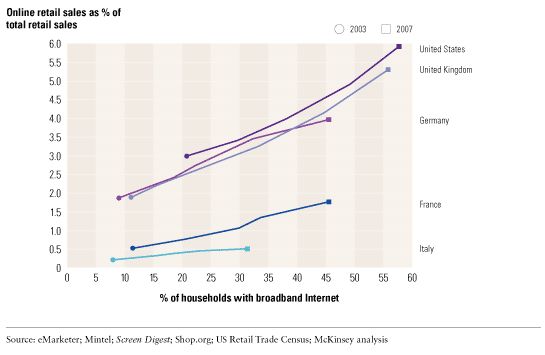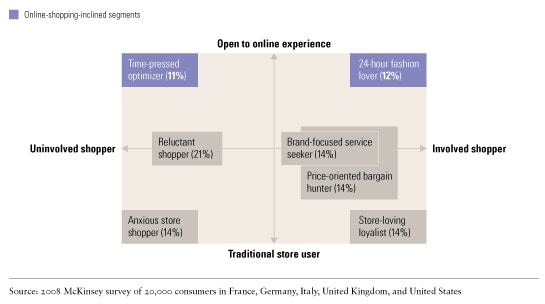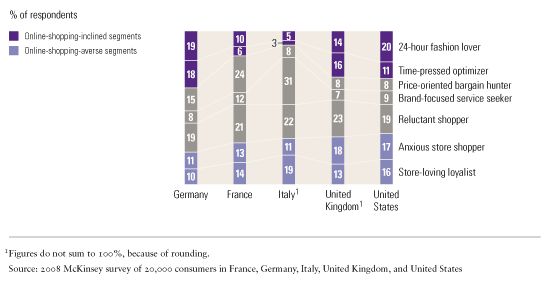Retail sales in Europe have been hit hard by the economic crisis, but as retailers struggle to navigate through the storm, they shouldn’t lose sight of the region’s longer-term shopping trends. Online sales have been growing there—rising 31 percent across France, Germany, Italy, the Netherlands, and the United Kingdom in 2007, according to the latest available aggregate data. Some signs indicate that Internet sales will continue to grow during the recession: last December, for example, UK online sales were up by 30 percent, compared with those of the previous year—even as sales in stores fell by 1.4 percent, British Retail Consortium figures show.
Our research, conducted last year before the crisis hit in earnest, suggests that to develop successful online strategies in Europe, retailers will need a deep understanding of factors such as levels of broadband penetration and the shopping attitudes that differentiate European retail markets. We queried 20,000 consumers in four large and culturally diverse ones—France, Germany, Italy, and the United Kingdom—as well as in the United States, for reference purposes. The goal was to learn about the shopping patterns and experiences, online and offline, of different retailers and product categories.
Not surprising, we found that broadband penetration can drive online sales growth. The United Kingdom, for instance, is rapidly catching up with online sales levels in the United States as UK broadband access levels approach US ones (Exhibit 1). Likewise, in Germany broadband penetration rose from 9 percent in 2003 to 45 percent in 2007 while online sales, excluding services and travel, increased to €13 billion, from €6 billion. The relationship didn’t hold in all markets, however. France, for instance, matched Germany’s broadband penetration rates in 2007, but its online retail sales were no more than half as high. Other factors, such as the reliability of home delivery systems and the passage of laws that guarantee a shopper’s right to return goods, can also affect online sales growth. A retailer must evaluate the potential barriers and the likelihood of overcoming them when it decides whether entering a new market is likely to be worthwhile.
Access drives sales

Such factors don’t reveal the whole picture, though. When we segmented our survey respondents, we found varying attitudes to online shopping within and among the four European markets. These differences suggest that retailers looking to move online or to raise their Internet sales must not only target the right segments but also take national variations into account before they develop a specific marketing mix.
Two segments with a natural affinity for online shopping emerged across most product categories. The truly multichannel “24-hour shoppers” love shopping and use the Internet to explore new ideas as well as to look for goods and services. “Time-pressed optimizers” find the Web a quick and hassle-free way to buy the things they need. But several segments, each with distinct characteristics, are averse to shopping online. “Store-loving loyalists,” for instance, enjoy the experience of shopping in stores with family and friends. “Anxious store shoppers” are particularly nervous about products and prefer to evaluate them in person. The consumer segments that have positive attitudes about online shopping are much larger in Germany, the United Kingdom, and the United States than they are in France (despite the country’s relatively high broadband penetration) and Italy. Large consumer segments in France and Italy are preoccupied with prices, brands, and service but have no strong preference for shopping on- or offline.
Retailers must determine which segments to pursue and then develop strategies that cater to the needs of those segments online. In the apparel industry, for example, we identified seven consumer segments (Exhibit 2). Retailers can benefit from the sizable German and UK segments—which have an affinity for online sales—providing rich, exciting Web content for the 24-hour fashion lovers and by improving processes and reliability for time-pressed optimizers (Exhibit 3). Nonetheless, it may be necessary to manage a trade-off between these two segments: the high-quality video offering that would excite the first may be an off-putting distraction for the second. In countries where segments with an affinity for online sales are smaller, retailers could invest in attracting certain consumer segments. In France, for example, retailers seeking to build an online presence would have to decide whether and how to address the needs of the “price-oriented bargain hunters”—that 24 percent of French shoppers who enjoy browsing in stores for the best bargains—by finding online ways to recreate a “rummage” experience.
For the love of fashion

National differences

This segmentation of European consumers will help retailers design effective marketing strategies with an appropriate mix of sales outlets and online channels for the target segments. It will be more necessary to tailor offers to each of them as more shoppers go online. With the recession making people ever more careful about how they spend their money, the pressure on retailers to market goods in smart and cost-efficient ways can only increase.